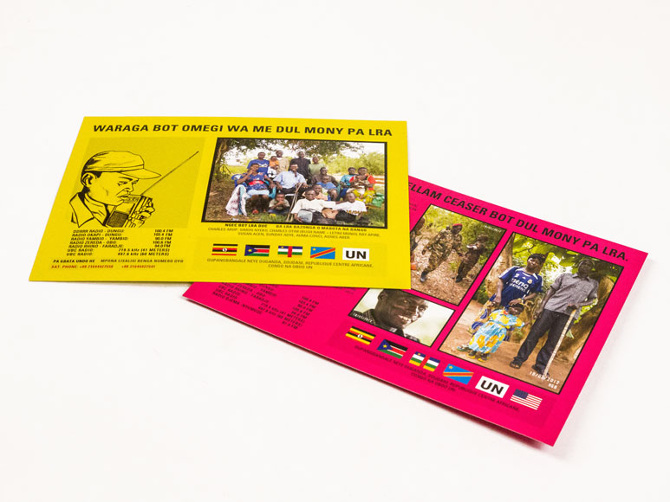Trigger warning: violence against children, psychological trauma
“The LRA know they don’t have a family anymore, so that is why when […] they see these guys with their families, it makes such a big difference, and it makes it very easy for them to feel like I can surrender and go back home”
Jolly Okot, Invisible Children // LRA Defection Flier
Formed in 1987, the Lord’s Resistance Army initially emerged in response to the Ugandan government’s repression of the Acholi population in the country’s Northern regions. Led by a former altar boy named Joseph Kony, the group sought to establish a theocratic state based on a modified version of the Ten Commandments. These overarching political ambitions, soon gave way to brutality, however, as the group attacked rural villages and engaged in the systematic deployment of torture and sexual violence. The LRA is most infamous for its campaign of child abductions. Since its founding, the group is estimated to have been responsible for the abduction of more than 25,000 Ugandan youths, with reports indicating that upwards of 90% of all LRA members first entered the group as children or adolescents.
Beginning in 2011, international assistance in tackling the LRA increased in intensity. Key to this was the large-scale employment of psychological operations, aimed at conveying specific information and narratives, to encourage defection within the LRA. Alongside the non-governmental organisation, Invisible Children, this effort centred on messages provided by ex-LRA combatants and local community members. Leaflets containing photographs of former LRA personnel reunited with their communities and detailed instructions for surrendering were produced and airdropped over the jungle; at the same time, local radio stations broadcast childhood songs and messages from family members urging their loved ones to emerge from the jungle. By 2013, the LRA’s capacity for armed violence had been severely weakened, with 80% of surrendering adult and child combatants citing the allure of home contained within the leaflets and radio messages as the catalyst for their defection. As one former LRA member stated:
“It’s better to spend Christmas at home than in the jungle”
Anonymous LRA Combatant, Coming Home
Peace, Home, and Hope
Much of my research for Visualising Peace in 2023 centred on the employment of behavioural psychology in international peace-building. One facet of this integration is psychological operations (PSYOPs), defined as planned activities directed towards specific audiences to influence their perceptions, attitudes and behaviours. Despite offering practitioners a vital capability to reduce the prevalence of violence without resorting to coercive force, their utility and relevance in peacebuilding is often questioned; in the words of one UN specialist, psychological operations are frequently vilified as the purview of “manipulative governments or interest groups.” Their employment against the LRA in the jungles of Northern Uganda indicates, however, that this is anything but the case.

(Image: Tyler Fordham Design)
As with any victim of conflict, the child soldiers of the LRA are permanently immersed in an environment defined by psychological trauma, stemming from the destruction of systems of care that grant individuals a sense of control and meaning in their lives. For LRA members, this destruction begins with their recruitment as children, with combatants forced to witness and commit acts of violence against their own community. Child soldiers are thus left to regard their offences as unforgivable, and a simplified narrative develops in which a clear distinction is drawn between one’s former family, to which they can never return, and the new family embodied by the group. In this sense, psychological trauma serves as a powerful perpetuating factor of armed conflict.
Overcoming this narrative of trauma-based group cohesion requires that any counter-messages be delivered by credible messengers. In the case of the LRA, community members recognised that violence perpetrated by child combatants was the result of coercion and sought the return of their loved ones. This feeling of coming home, carried in the messages from those who supposedly viewed them as irredeemable, offered the powerful narrative of forgiveness and hope needed to challenge the psychological trauma which trapped combatants in the LRA and encourage their surrender. Peace can undoubtedly be conceptualised as a political or social end, but, for the adult and child fighters of the LRA, peace was represented by something far simpler yet, to many, seemingly impossible to reach – home. It was by directly appealing to this visualisation of peace that the psychological operations campaign against the LRA achieved success without a single shot being fired.
What Do You Think?
- What role do themes of family and home play in your visualisation of peace?
- Can the presence of family and community truly be excluded from any understanding of peace? And what, if anything, does this tell us about the relationship between personal peace and geopolitical peace?
- Are efforts to influence the opinions, beliefs, and behaviour of an individual or group incompatible with peace-building? Or are they vital? What other examples have you come across?
- What are the risks? And what checks and balances might be needed to deploy psychological methods ethically?
If you enjoyed this item in our museum…
You might also enjoy Peace on the Airwaves, Morning Light and Peace after Radicalisation, (Un)Natural Altruism, Journey for Forgiveness and Moral Injury: Healing.
Mathias Katsura, April 2023